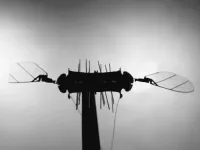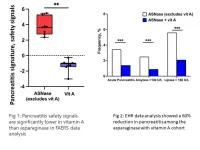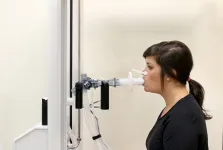(Press-News.org) Bumblebees are clumsy fliers. It is estimated that a foraging bee bumps into a flower about once per second, which damages its wings over time. Yet despite having many tiny rips or holes in their wings, bumblebees can still fly.
Aerial robots, on the other hand, are not so resilient. Poke holes in the robot’s wing motors or chop off part of its propellor, and odds are pretty good it will be grounded.
Inspired by the hardiness of bumblebees, MIT researchers have developed repair techniques that enable a bug-sized aerial robot to sustain severe damage to the actuators, or artificial muscles, that power its wings — but to still fly effectively.
They optimized these artificial muscles so the robot can better isolate defects and overcome minor damage, like tiny holes in the actuator. In addition, they demonstrated a novel laser repair method that can help the robot recover from severe damage, such as a fire that scorches the device.
Using their techniques, a damaged robot could maintain flight-level performance after one of its artificial muscles was jabbed by 10 needles, and the actuator was still able to operate after a large hole was burnt into it. Their repair methods enabled a robot to keep flying even after the researchers cut off 20 percent of its wing tip.
This could make swarms of tiny robots better able to perform tasks in tough environments, like conducting a search mission through a collapsing building or dense forest.
“We spent a lot of time understanding the dynamics of soft, artificial muscles and, through both a new fabrication method and a new understanding, we can show a level of resilience to damage that is comparable to insects. We’re very excited about this. But the insects are still superior to us, in the sense that they can lose up to 40 percent of their wing and still fly. We still have some catch-up work to do,” says Kevin Chen, the D. Reid Weedon, Jr. Assistant Professor in the Department of Electrical Engineering and Computer Science (EECS), the head of the Soft and Micro Robotics Laboratory in the Research Laboratory of Electronics (RLE), and the senior author of the paper on these latest advances.
Chen wrote the paper with co-lead authors and EECS graduate students Suhan Kim and Yi-Hsuan Hsiao; Younghoon Lee, a postdoc; Weikun “Spencer” Zhu, a graduate student in the Department of Chemical Engineering; Zhijian Ren, an EECS graduate student; and Farnaz Niroui, the EE Landsman Career Development Assistant Professor of EECS at MIT and a member of the RLE. The article will appear in Science Robotics.
Robot repair techniques
The tiny, rectangular robots being developed in Chen’s lab are about the same size and shape as a microcassette tape, though one robot weighs barely more than a paper clip. Wings on each corner are powered by dielectric elastomer actuators (DEAs), which are soft artificial muscles that use mechanical forces to rapidly flap the wings. These artificial muscles are made from layers of elastomer that are sandwiched between two razor-thin electrodes and then rolled into a squishy tube. When voltage is applied to the DEA, the electrodes squeeze the elastomer, which flaps the wing.
But microscopic imperfections can cause sparks that burn the elastomer and cause the device to fail. About 15 years ago, researchers found they could prevent DEA failures from one tiny defect using a physical phenomenon known as self-clearing. In this process, applying high voltage to the DEA disconnects the local electrode around a small defect, isolating that failure from the rest of the electrode so the artificial muscle still works.
Chen and his collaborators employed this self-clearing process in their robot repair techniques.
First, they optimized the concentration of carbon nanotubes that comprise the electrodes in the DEA. Carbon nanotubes are super-strong but extremely tiny rolls of carbon. Having fewer carbon nanotubes in the electrode improves self-clearing, since it reaches higher temperatures and burns away more easily. But this also reduces the actuator’s power density.
“At a certain point, you will not be able to get enough energy out of the system, but we need a lot of energy and power to fly the robot. We had to find the optimal point between these two constraints — optimize the self-clearing property under the constraint that we still want the robot to fly,” Chen says.
However, even an optimized DEA will fail if it suffers from severe damage, like a large hole that lets too much air into the device.
Chen and his team used a laser to overcome major defects. They carefully cut along the outer contours of a large defect with a laser, which causes minor damage around the perimeter. Then, they can use self-clearing to burn off the slightly damaged electrode, isolating the larger defect.
“In a way, we are trying to do surgery on muscles. But if we don’t use enough power, then we can’t do enough damage to isolate the defect. On the other hand, if we use too much power, the laser will cause severe damage to the actuator that won’t be clearable,” Chen says.
The team soon realized that, when “operating” on such tiny devices, it is very difficult to observe the electrode to see if they had successfully isolated a defect. Drawing on previous work, they incorporated electroluminescent particles into the actuator. Now, if they see light shining, they know that part of the actuator is operational, but dark patches mean they successfully isolated those areas.
Flight test success
Once they had perfected their techniques, the researchers conducted tests with damaged actuators — some had been jabbed by many needles while other had holes burned into them. They measured how well the robot performed in flapping wing, take-off, and hovering experiments.
Even with damaged DEAs, the repair techniques enabled the robot to maintain its flight performance, with altitude, position, and attitude errors that deviated only very slightly from those of an undamaged robot. With laser surgery, a DEA that would have been broken beyond repair was able to recover 87 percent of its performance.
“I have to hand it to my two students, who did a lot of hard work when they were flying the robot. Flying the robot by itself is very hard, not to mention now that we are intentionally damaging it,” Chen says.
These repair techniques make the tiny robots much more robust, so Chen and his team are now working on teaching them new functions, like landing on flowers or flying in a swarm. They are also developing new control algorithms so the robots can fly better, teaching the robots to control their yaw angle so they can keep a constant heading, and enabling the robots to carry a tiny circuit, with the longer-term goal of carrying its own power source.
This work is funded, in part, by the National Science Foundation (NSF) and a MathWorks Fellowship.
###
Written by Adam Zewe, MIT News Office
END
Resilient bug-sized robots keep flying even after wing damage
New repair techniques enable microscale robots to recover flight performance after suffering severe damage to the artificial muscles that power their wings.
2023-03-15
ELSE PRESS RELEASES FROM THIS DATE:
Psychological intervention reduced stress during COVID lockdown
2023-03-15
Resilience and well-being in difficult times can be developed via online interventions in the workplace. An international team of researchers from France, the UK and Russia (with the participation of researchers from the HSE International Laboratory of Positive Psychology of Personality and Motivation) studied the effectiveness of SPARK Resilience, a programme for developing resilience, at the beginning of the COVID-19 pandemic. The results of the study were published in the PLOS One journal.
By creating the SPARK Resilience programme, psychologists focused on helping people gain ...
Biotechnologies harnessing microbes might enable us to extract rare elements and minerals, chemicals and fuels from wastewater
2023-03-15
Biotechnologies harnessing microbes might enable us to extract rare elements and minerals, chemicals and fuels from wastewater.
####
Article URL: https://journals.plos.org/water/article?id=10.1371/journal.pwat.0000105
Article Title: Environmental biotechnologies can make water pollutants part of the path to mitigating climate change
Author Countries: USA
Funding: The author received no specific funding for this work.
END ...
Vitamin A may reduce pancreatitis risk during ALL treatment
2023-03-15
Consuming a diet rich in vitamin A or its analogs may help prevent children and young adults with acute lymphoblastic leukemia (ALL) reduce their risk of developing painful pancreas inflammation during chemotherapy treatment.
Details about this potential dietary solution to prevent a potentially life-threatening adverse event were published March 15, 2023, in Science Translational Medicine. The research team was led by Sohail Husain, MD, chief of Pediatric Gastroenterology, Hepatology, and Nutrition at Stanford University and Anil Goud Jegga, DVM, MRes, a computational ...
UAF scientist offers evidence that Venus is volcanically active
2023-03-15
Embargoed: Not for release until 2 p.m. U.S. Eastern time Wednesday, March 15, 2023
Venus appears to have volcanic activity, according to a new research paper that offers strong evidence to answer the lingering question about whether Earth’s sister planet currently has eruptions and lava flows.
Venus, although similar to Earth in size and mass, differs markedly in that it does not have plate tectonics. The boundaries of Earth’s moving surface plates are the primary locations of volcanic activity.
New research by University of Alaska Fairbanks Geophysical Institute research professor Robert Herrick revealed ...
A nonnative tree species reclaims its prominence after extreme weather
2023-03-15
The long-term effects on forests of more extreme climate events, plus other drivers of forest change, are highly uncertain. A new study of the tropical forests across Puerto Rico and the U.S. Virgin Islands (USVI), spanning 19 years, found that after Hurricane Maria in 2017, the total biomass of a fast-growing nonnative species, the African tulip Tree (Spathodea campanulata), may again be overtaking that of the most common group of native tree species, even though, at least for young and small trees, nonnatives ...
Antidepressant medication may be key to help people stop use of cocaine while in treatment for opioid use disorder
2023-03-15
For some people receiving methadone for treatment of opioid use disorder (OUD), the co-use of opioids and stimulants such as cocaine is an issue. Now, a new study led by Johns Hopkins Medicine researchers found that bupropion, an antidepressant medication also used for smoking cessation, may help people stop using cocaine while in treatment for OUD.
The results of the study were published March 15 in JAMA Network Open.
For this double-blind randomized study, the researchers used an adaptive treatment design, meaning that it allowed ...
Zook joins The Gerontological Society of America’s Board of Directors
2023-03-15
The Gerontological Society of America (GSA) — the nation’s largest interdisciplinary organization devoted to the field of aging — has named David Zook of Faegre Drinker LLP as an at-large member of its Board of Directors.
GSA’s Board of Directors provides governance oversight, establishes Society policy, sets the organization’s strategic plan, and oversees implementation thereof. It comprises 12 members representing the broad diversity of the Society’s membership. Zook’s three-year term became effective January 1.
“GSA is very effective in applying knowledge to policymaking as the role of older individuals in our society continues to evolve,” ...
Breakthrough drug combination remains safe and effective in patients with cystic fibrosis after four years
2023-03-15
Patients with cystic fibrosis (CF) face difficulty breathing and a decline in lung function and are at risk of early death. CF is an inherited condition that results in thick mucus build-up, persistent infection and inflammation in the lungs.
Medical University of South Carolina (MUSC) researcher Patrick Flume, M.D., was lead author of a recent Journal of Cystic Fibrosis article reporting the findings of a trial of a two-drug combination for treating CF. The study demonstrated long-term safety and clinical benefit of the combination therapy. Flume is director of the ...
Remains of a modern glacier found near mars’ equator implies water ice possibly present at low latitudes on Mars even today
2023-03-15
March 15, 2023, Mountain View, California – In a groundbreaking announcement at the 54th Lunar and Planetary Science Conference held in The Woodlands, Texas, scientists revealed the discovery of a relict glacier near Mars' equator. Located in Eastern Noctis Labyrinthus at coordinates 7° 33' S, 93° 14' W, this finding is significant as it implies the presence of surface water ice on Mars in recent times, even near the equator. This discovery raises the possibility that ice may still exist at shallow depths in the ...
Associations between teacher and student mathematics, science, and literacy anxiety in fourth grade
2023-03-15
Educational Impact and Implications Statement
We investigated associations among teachers’ and students’ anxiety in mathematics, science, and literacy. We found that teachers’ anxiety in mathematics and science was associated with the mathematics and science anxiety of their low-SES students. Results highlight STEM content areas as contexts in which transmission of negative emotions between teachers and students may take place, as well as highlight the particular impacts these processes might have on students from underserved socioeconomic backgrounds.
The ...
LAST 30 PRESS RELEASES:
Autonomous AI agents developed to detect early signs of cognitive decline
Study finds ocean impacts nearly double economic cost of climate change
Increased deciduous tree dominance reduces wildfire carbon losses in boreal forests
Researchers discover how a respiratory bacterium obtains essential lipids from the human body and targets fat-rich tissues
Locust swarms destroy crops. Scientists found a way to stop that
More resources and collaboration needed to support prevention and treatment of obesity
Two types of underconfidence linked to anxiety and gender
Insects are victims too: Global study shows impacts of invasive alien species on populations
Pioneering natural, degradable polymer capsules
Forestry is becoming digital and automated
Maternity baby deaths much higher in northern England than in the South
Mosquitoes’ thirst for human blood has increased as biodiversity loss worsens
The stop-smoking medication varenicline may also work for cannabis use disorder
Potential new treatment for sepsis
Study reveals how many hours of video games per week might be too many
Electrospinning for mimicking bioelectric microenvironment in tissue regeneration
Home fingertip oxygen monitors less accurate for people with darker skin tones
Six weeks in a cast no less effective than surgery for unstable ankle fractures
Precautionary approach to alcohol-free and low alcohol drinks needed to protect public health, say experts
Gas-atomized Ca–Mg alloy powders produce hydrogen simply by adding water — high-efficiency hydrogen generation at room temperature
British redcoat’s lost memoir reveals harsh realities of life as a disabled veteran
World-leading rare earth magnet recycling facility launches in UK
Corday Selden selected for the Oceanography Society Early Career Award
MIT chemists determine the structure of the fuzzy coat that surrounds Tau proteins
Same moves, different terrain: How bacteria navigate complex environments without changing their playbook
Severe weather is deadly for vulnerable older adults long after the storm ends, study finds
Expert panel highlights opportunities for improving cancer studies
Hearing aid prescriptions not associated with changes in memory and thinking
Seth Zippel selected for The Oceanography Society Early Career Award
Jeremy Horowitz selected for The Oceanography Society Early Career Award
[Press-News.org] Resilient bug-sized robots keep flying even after wing damageNew repair techniques enable microscale robots to recover flight performance after suffering severe damage to the artificial muscles that power their wings.




